Jacob Neestrup has brought a refreshing tactical approach to FC Copenhagen, also known as FC København, transforming the team’s style and effectiveness on the pitch. His strategy combines a disciplined structure with fluid attacking play, which has allowed FC Copenhagen to challenge opponents both domestically and in European competitions. This analysis dives into Neestrup’s tactical framework, exploring the key formations, player roles, and game strategies that define his tenure. From defensive organization to creative offensive maneuvers, we’ll break down the elements that make Neestrup’s FC Copenhagen an exciting team to watch.
Build-up
In the build-up, Neestrup sets his team up in a 1-4-3-3 formation, with a back four, one number-six, two number-eights, and a front three.
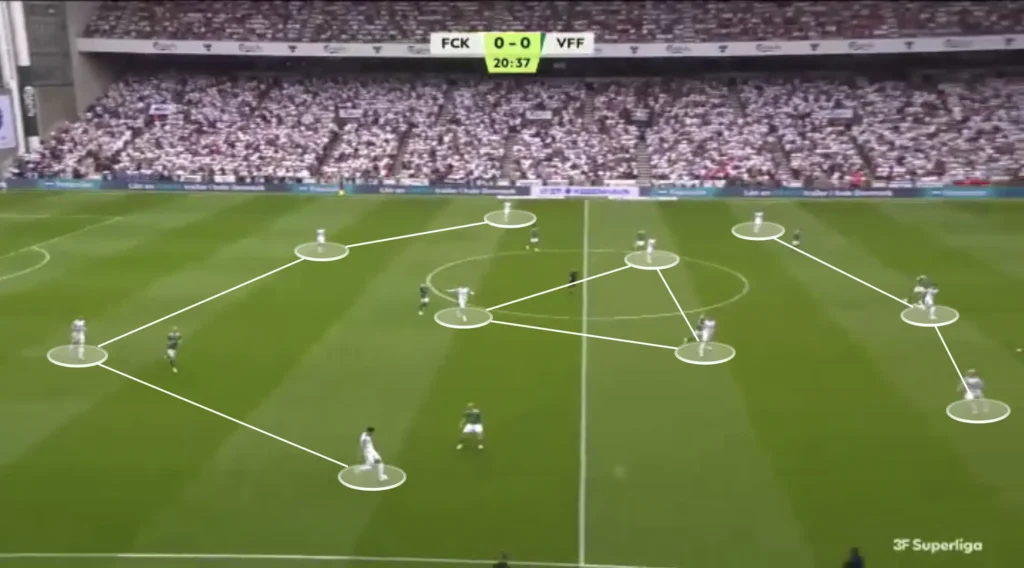
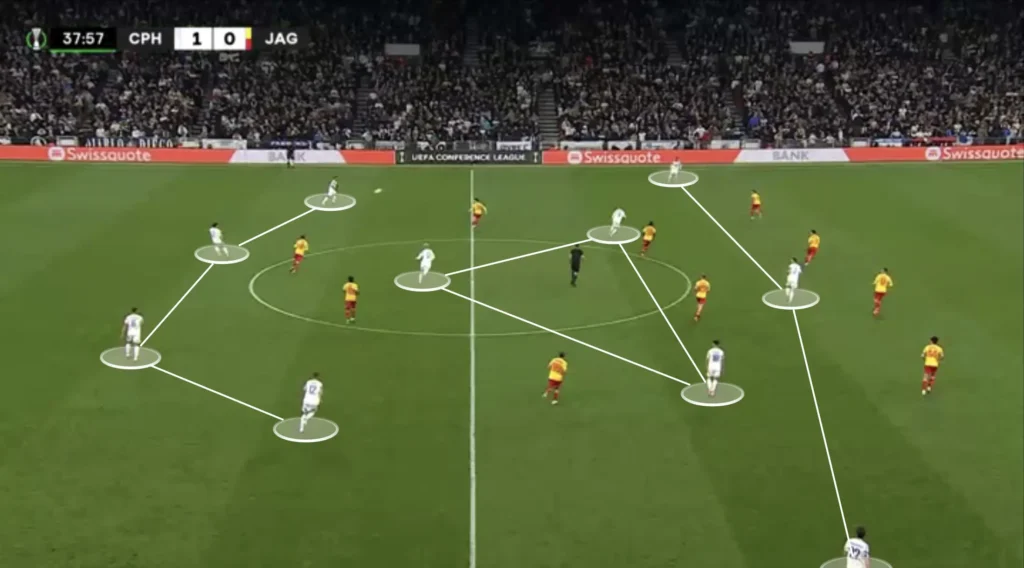
Building up in a 1-4-3-3 formation focuses on creating a solid foundation at the back while maintaining fluidity and options in the midfield. The formation begins with four defenders, who provide width and stability, allowing for controlled possession from deep areas. The single defensive midfielder connects the defense to the midfield, dictating the tempo and distributing the ball to the two more advanced central midfielders. These midfielders position themselves to exploit spaces between the opposition’s lines, creating passing triangles that facilitate smooth progression up the pitch. The three forwards, with the central striker as the focal point, are always ready to receive the ball, either through direct passes or by making runs behind the defense. This setup allows the team to transition quickly from attack to defense, maintaining pressure on the opponent while ensuring defensive coverage.
Rotations and Fluidity
The Copenhagen players constantly rotate during the build-up. The team adopts a dynamic approach, shifting between formations to create numerical advantages and exploit spaces. Neestrup’s focus is always to get the players into their best positions, where they can make the most out of their individual skills. He emphasizes versatility, with players interchanging positions seamlessly to maintain possession and disrupt the opposition’s defensive structure. This flexibility creates numerical superiorities in different areas, allowing Copenhagen to bypass the opposition’s press while maintaining control.
Copenhagen will, for example, often invert one of the fullbacks, usually the left-back, in the build-up. By pushing one of their fullbacks into the central midfield area, they create a numerical advantage in the middle of the pitch. This inversion allows them to overload the midfield, offering additional passing options and helping them bypass the opponent’s first line of press. Additionally, when the fullbacks invert, the opposition wingers usually follow to cover the run, which opens the passing lane from the center-back to the winger. The center-back can play the ball to the winger, who can attack the defense and combine with a teammate to create a 2v1 situation against the opposition fullback.

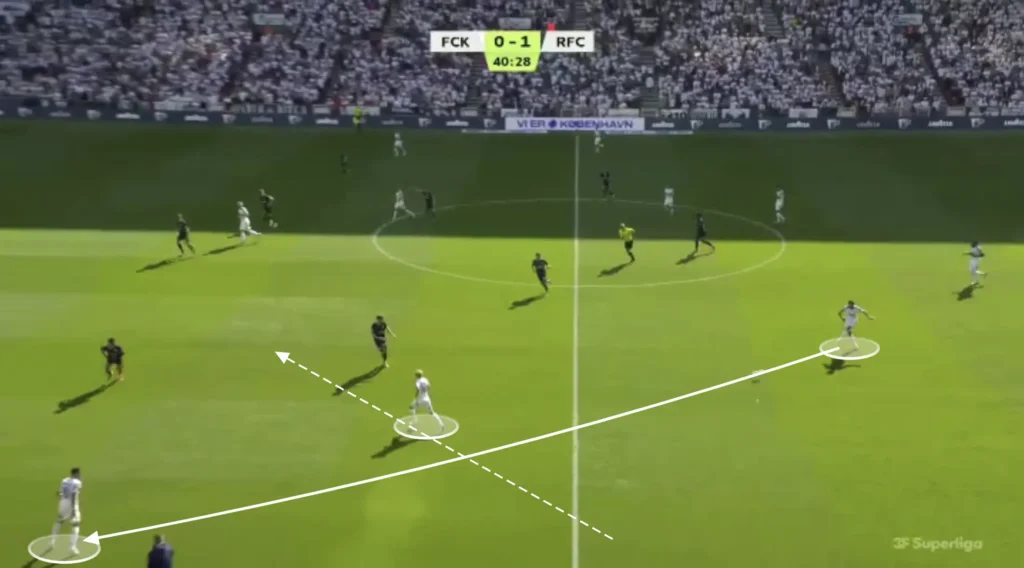
Copenhagen also employs an interesting tactic by inverting their right-winger during the build-up phase. This means the right-winger tucks inside while the right-sided number-eight moves into a number-ten position. This adjustment creates several tactical advantages: it allows Copenhagen to have an extra player in the midfield, helping them control possession and maintain a numerical advantage against the opposition’s central midfielders. Additionally, this inverted movement opens space on the right flank, which the fullback can exploit by advancing higher up the pitch.
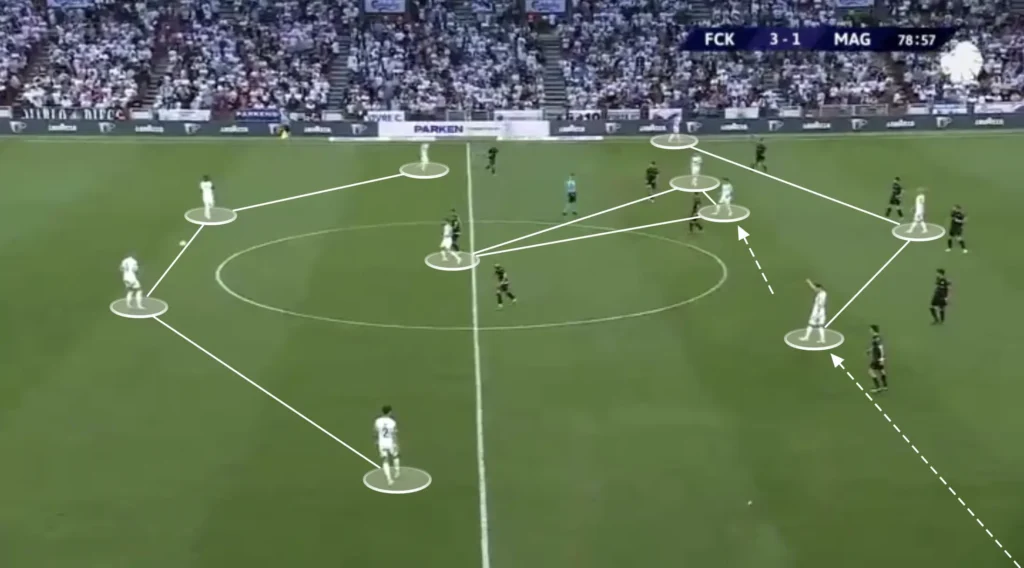
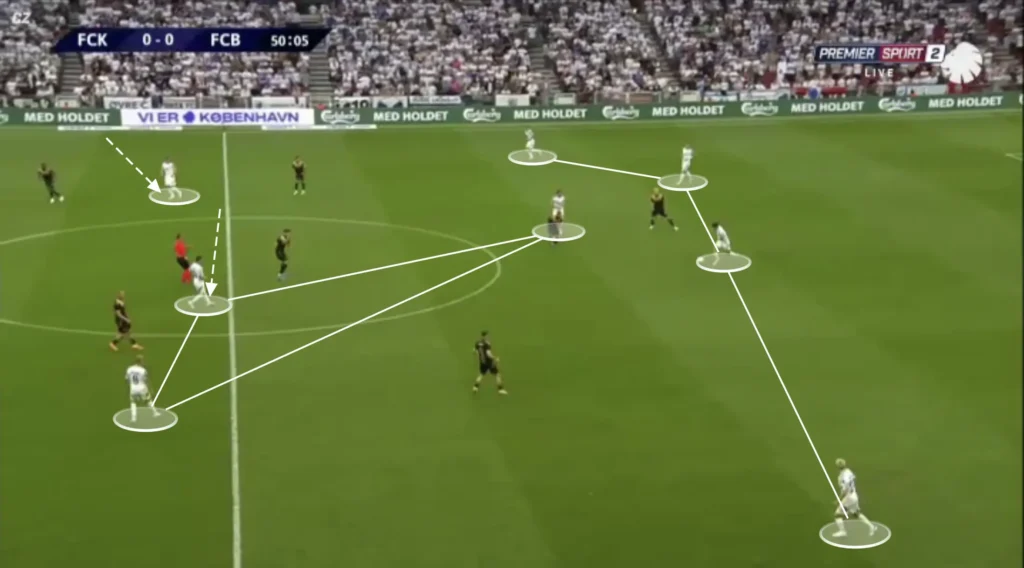
Creating a Back Three
When the right-winger comes into the middle, the right-back often pushes up into the right-wing position while the left-back comes in next to the center-backs. This shift creates a back three, allowing Copenhagen to maintain defensive stability while gaining more control in possession.
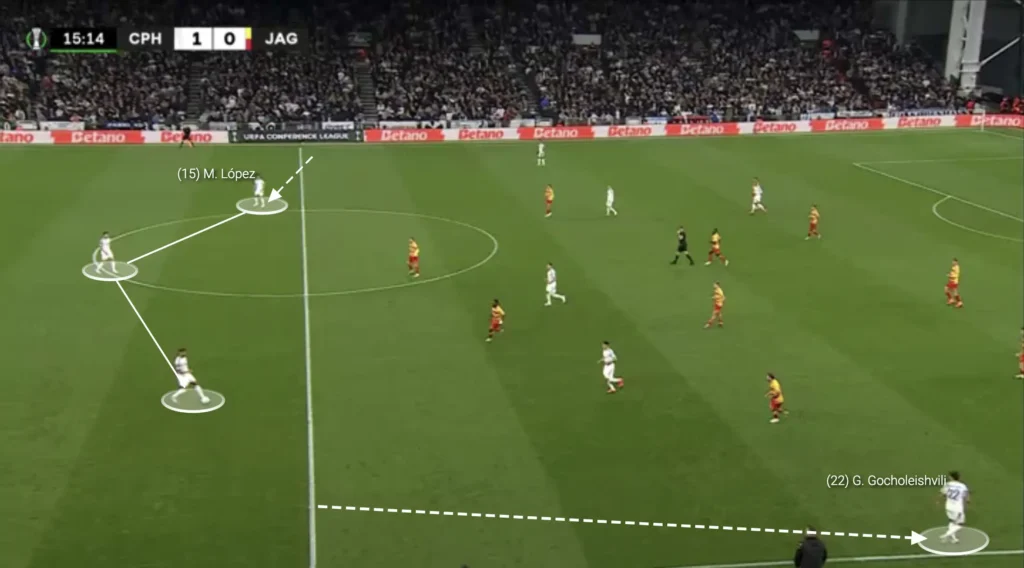
By doing this, Copenhagen not only widen the field but also open up different angles for passing, making it easier to beat the opposition’s press. This tactical adjustment gives them more options in progressing the ball up the field and disrupts the opponent’s pressing structure, helping them maintain fluidity in their play.
Copenhagen will also create a back three in the build-up by dropping down with the holding midfielder.
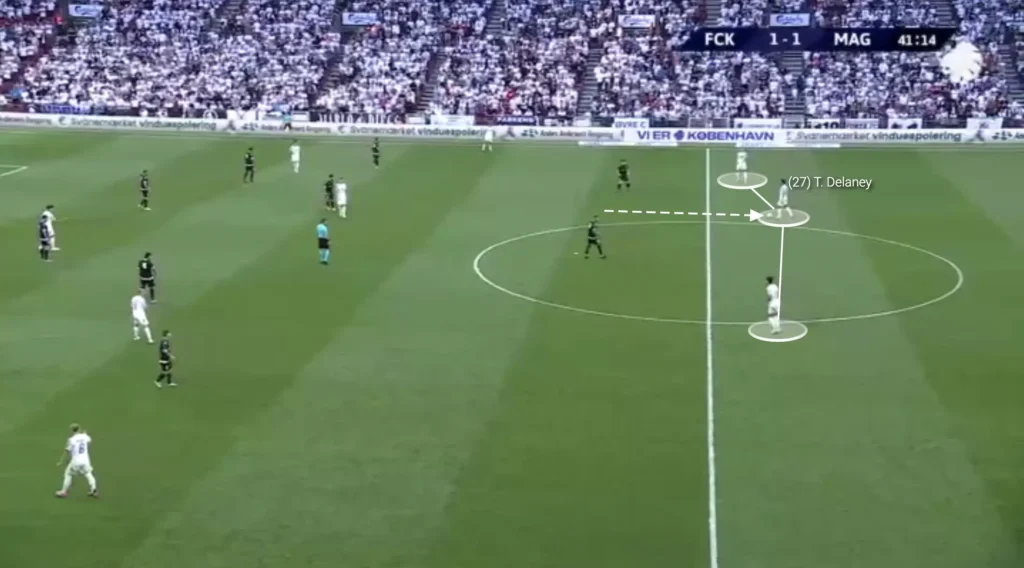
When using a back three, Copenhagen will either set up in a 1-3-2-5 formation or a 1-3-1-5-1 formation.
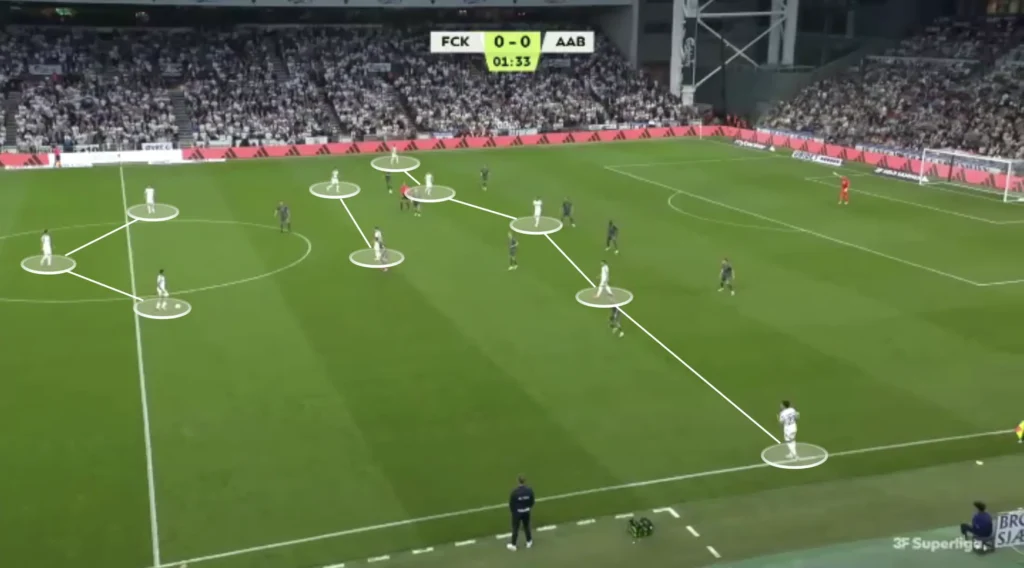
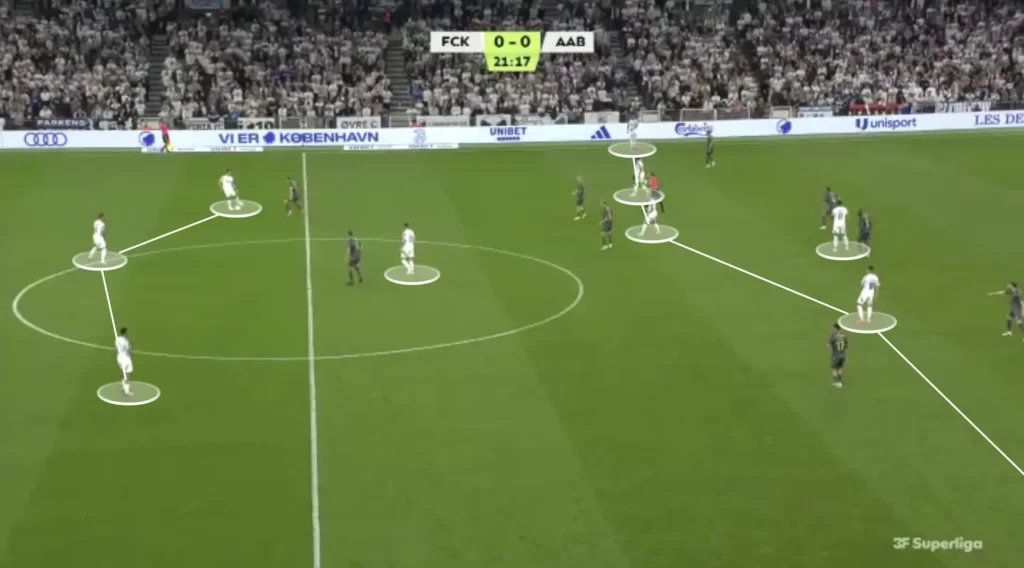
The 1-3-1-5-1 is generally more aggressive, as it emphasizes forward thrust and allows for overloads in attacking zones, while the 1-3-2-5 provides a bit more security and balance, particularly in transition phases.
Numerical Advantage in the Midfield
Regardless of the formation, Copenhagen will have many players in the center. Neestrup usually has one wide player on each side and positions the remaining eight players in the middle.
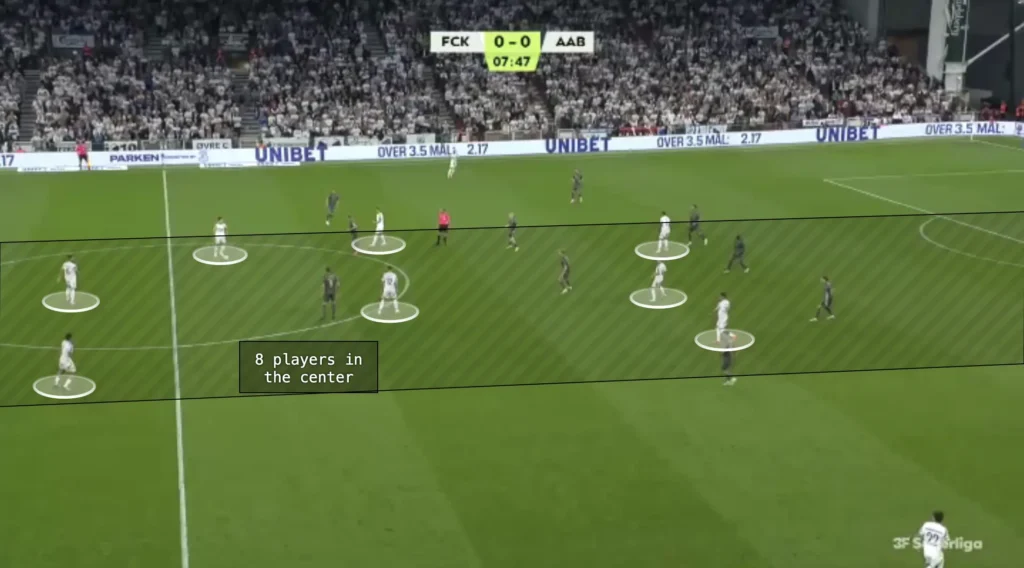
Having only two players out wide and the rest in the middle creates more options in the center and less space between the players. Neestrup likes this because he prioritizes playing through the middle. He needs one player out wide to pull the opposition apart while the rest create numerical advantages in the midfield areas. When a team outnumbers the opposition in the midfield, it can more easily retain the ball, exploit spaces, and progress the ball through the center. Copenhagen will often progress the ball through quick central passes between the midfielders, beating the opposition’s press and exploiting gaps in the defense. At the same time, having many players centrally builds good conditions in defensive transitions since it allows more players to counterpress when they lose the ball.
Another purpose for keeping many players in the middle is to shorten the distance between them. This shortens the length of the passes, which naturally shortens the time between passes. This means the opposition players will have less time to push up and press, giving the Copenhagen players more time and control.
Using the Goalkeeper
Jacob Neestrup likes using the goalkeeper in the build-up. The Copenhagen goalkeeper will often push up between the center-backs, giving Neestrup’s team an extra man in the build-up phase.
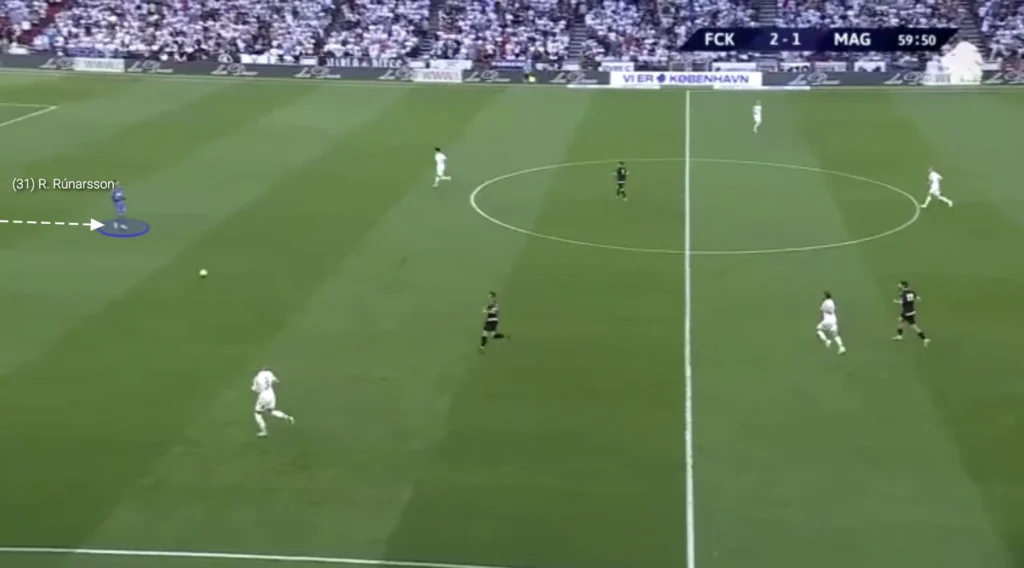
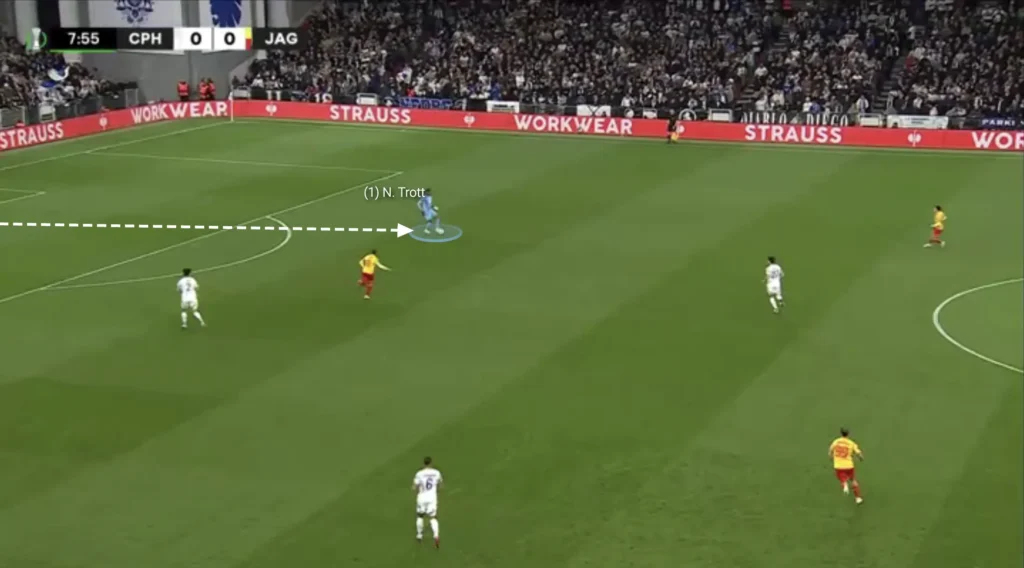
Using the goalkeeper in the build-up phase offers numerous tactical advantages. By involving the goalkeeper, Copenhagen can create numerical superiority at the back, making it easier to evade the opponent’s press and maintain possession. This additional player allows for more passing options, reducing the risk of losing possession and enabling smoother transitions from defense to attack. The goalkeeper can also act as a pivot, switching play across the field to exploit weak points in the opposition’s formation. Furthermore, involving the goalkeeper helps in drawing the opposition forward, creating space higher up the pitch for attackers to exploit.
High Backline
A massive aspect of Neestrup’s high possession build-up is to have the defenders high up. This helps in the counterpress because they get closer to the midfield. Having more players close to the center who can win the ball back makes it difficult for the opposition to do anything when they win possession. Furthermore, the high backline shortens the distance between players, shortening the time and length of the passes and preventing the opposition from pushing up their defense.
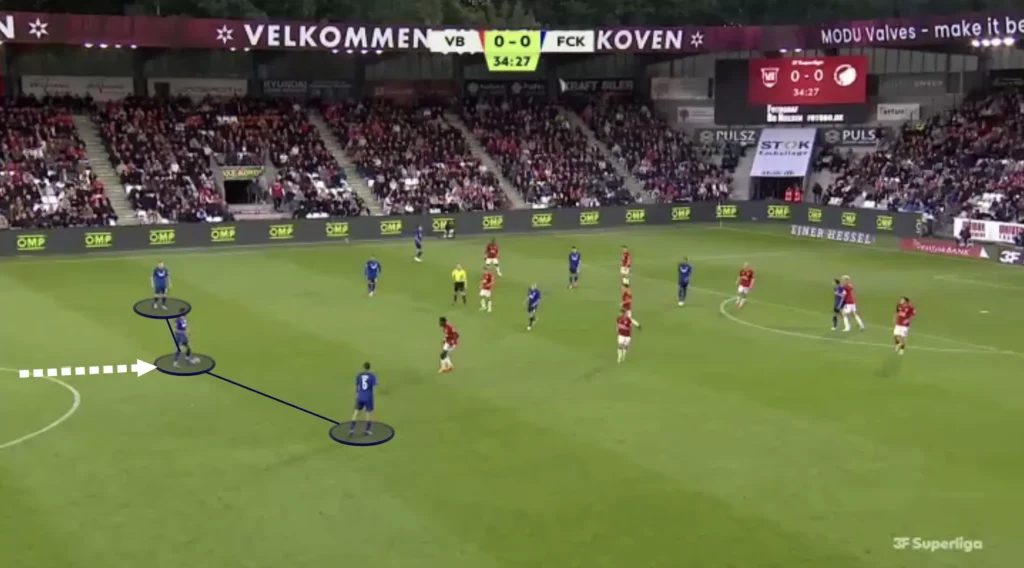
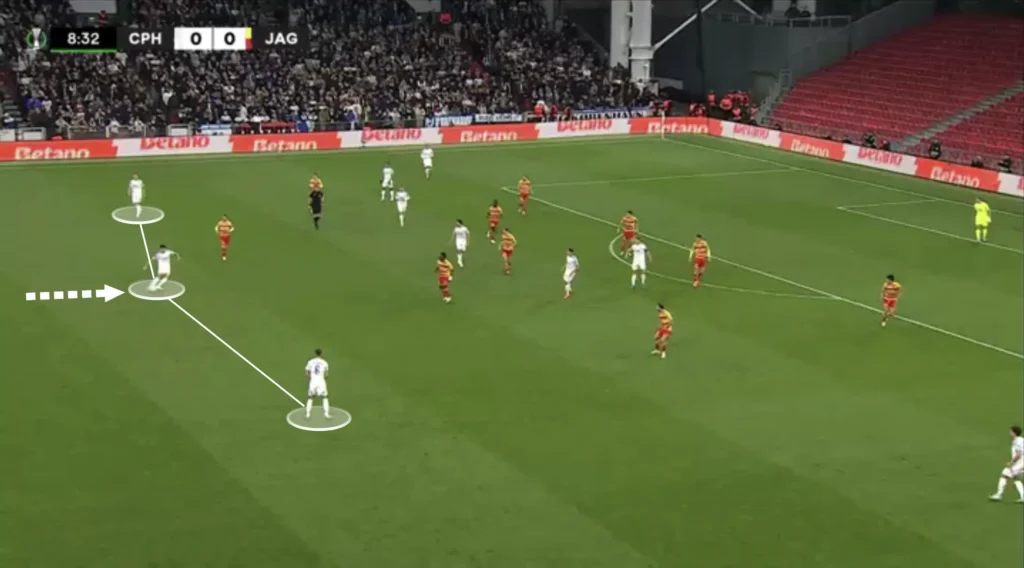
Balls in Behind
The Copenhagen attackers consistently make aggressive runs in behind the opposition defense whenever the Copenhagen defenders have time with the ball. This movement is a key aspect of their offensive strategy, designed to stretch the defensive line and create space. As the defenders advance the ball, the forwards will run in behind the opposition backline, exploiting gaps between defenders and allowing themselves to receive well-placed through-balls. The coordination between the defenders and attackers makes Copenhagen’s offense unpredictable and difficult to defend against.

The Copenhagen players lower down the pitch, mainly the fullbacks, will also make runs in behind when the center-backs or defensive midfielders have the ball. These runs can disrupt the opposition’s defensive organization, as the fullback’s forward movements are difficult to pick up and often pull defenders out of position. Additionally, it adds an element of surprise since fullbacks are traditionally expected to stay back, making it harder for defenders to predict and cover these movements.
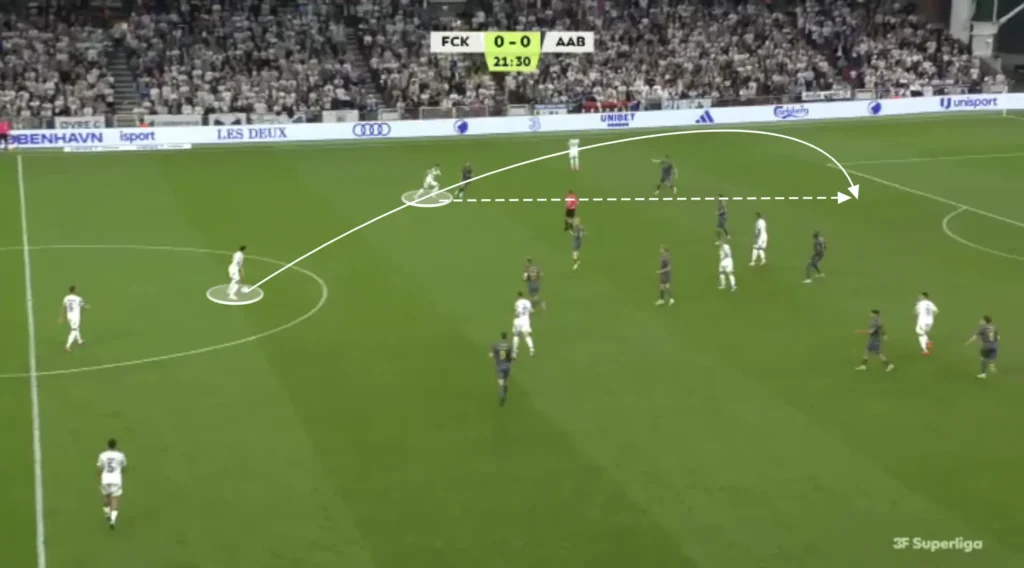
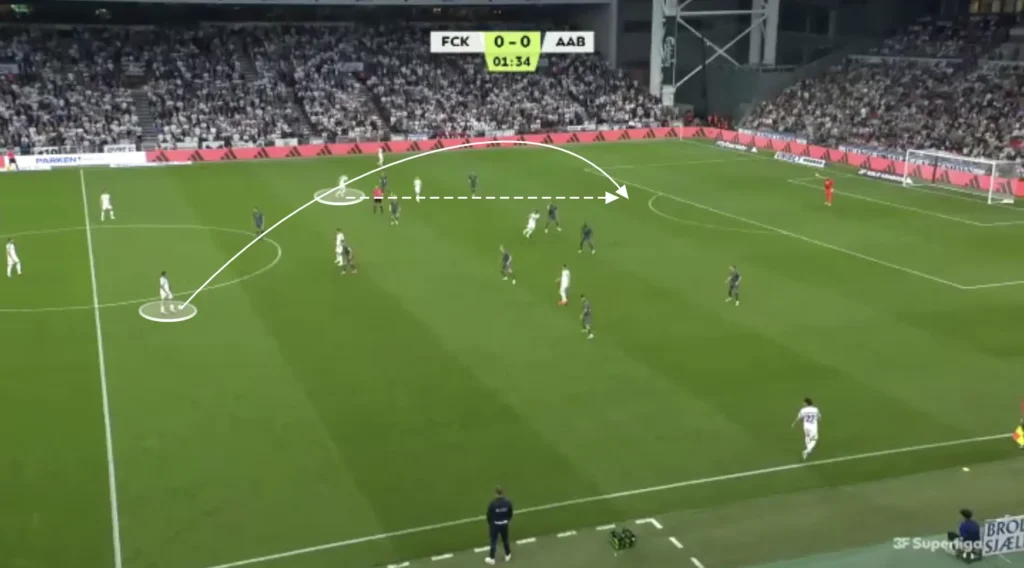
The constant threat of runs in behind the defense prevents the opposition from playing with a high backline and closing the space between the lines. Instead, they have to drop the backline and protect the space in behind. This opens the space in front of the backline for the Copenhagen midfielders to exploit.
Numerical Advantages Against the Opposition’s Defense
Another massive aspect of Copenhagen’s high build-up is their ability to create numerical advantages against the opposition’s defensive line. Even though the structure is very fluid, the team will usually have five or more players in the forward line. Playing with a front five means the forward line naturally becomes numerically superior against a back four.
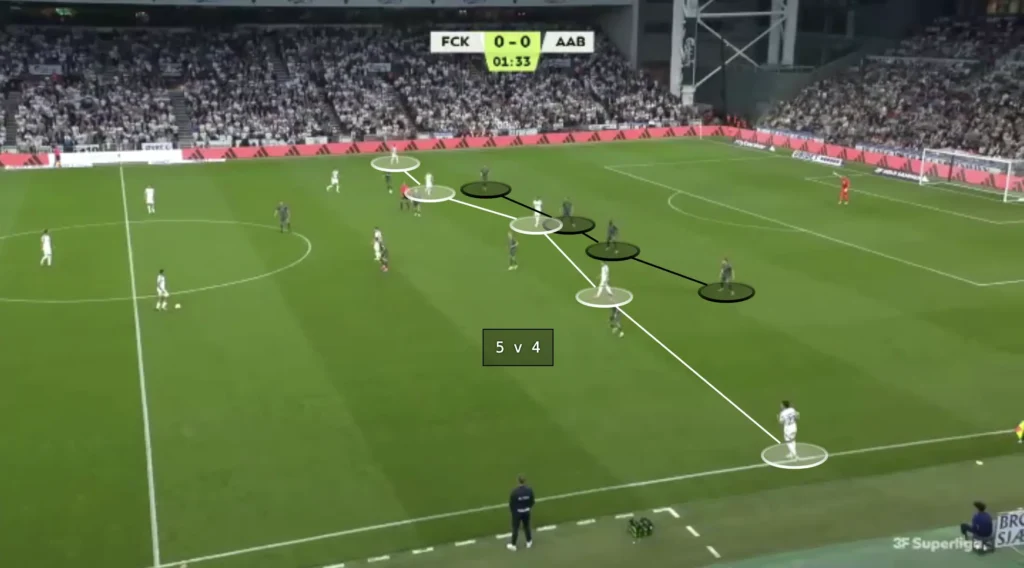
The Copenhagen players are great at taking advantage of this. They mainly exploit this by creating 2v1 situations against the opposition fullback. When the defending team is positioned on one side, the weak-side fullback becomes vulnerable to the switch of play due to the 1v2 against Copenhagen’s winger and attacking midfielder. The attacking midfielder will make a run in behind, the fullback will follow that run, and the space for the winger out wide will be opened. Neestrup’s team often capitalizes on this by getting the ball to the winger and creating many opportunities from 2v1 situations on the wing and in the half-spaces.
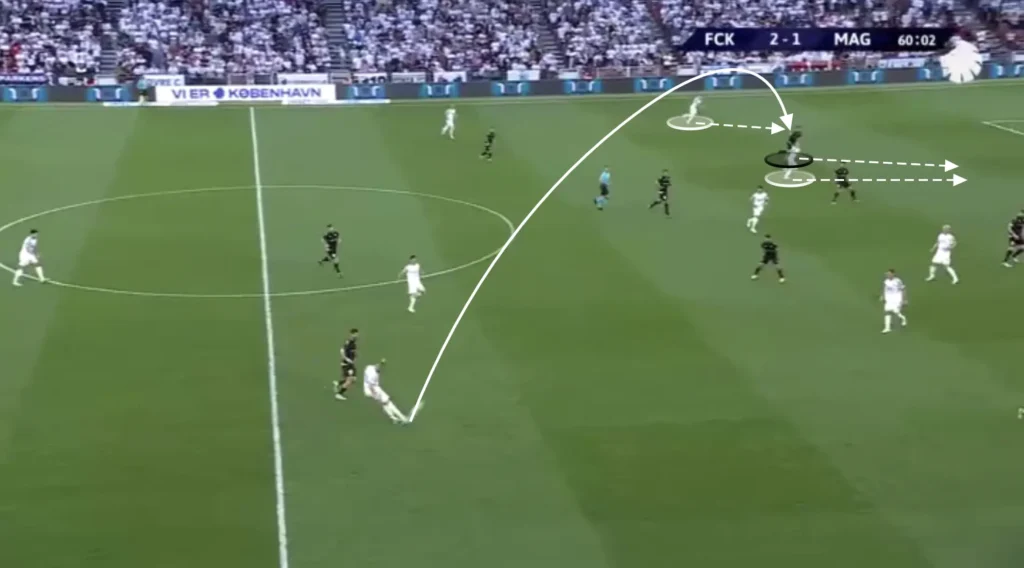
If the opposition fullback does not follow the attacking midfielder’s run, a through-ball could be played straight to the attacking midfielder, who could take the ball forward and create a 1v1 against the goalkeeper.
Final Third
Attacking the Half-Space
Neestrup’s players usually look to create chances by attacking the space between the opposition center-back and fullback. They primarily do this from the wide areas with underlaps from the attacking midfielders. When the winger receives the ball out wide he will attract the opposition fullback. This opens the space between the fullback and the center-back, which allows Copenhagen’s attacking midfielder to make the underlapping run into this space. The ball can be played to the underlapping player, who can cross the ball into the box or attack his defender in a 1v1 situation.
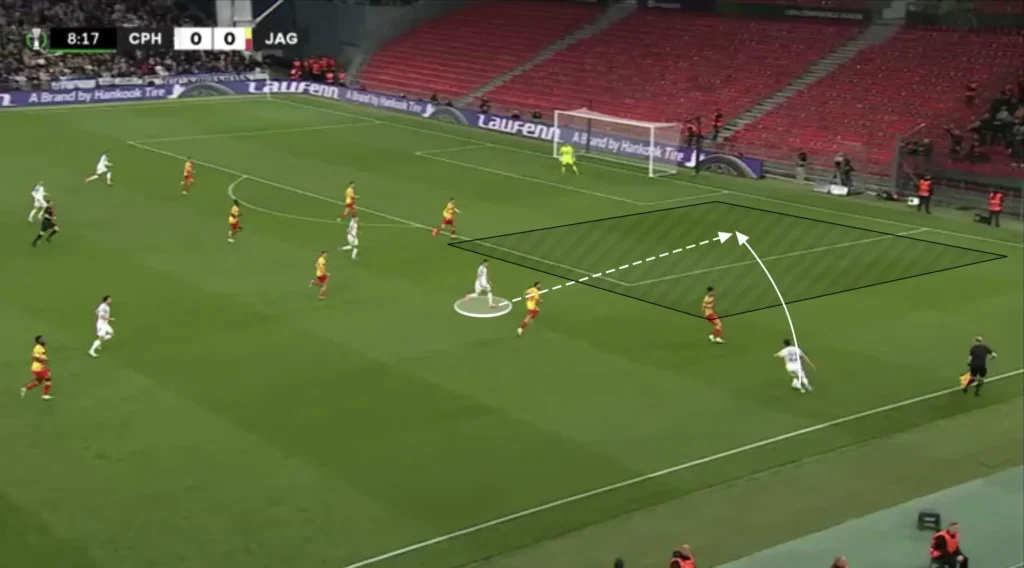
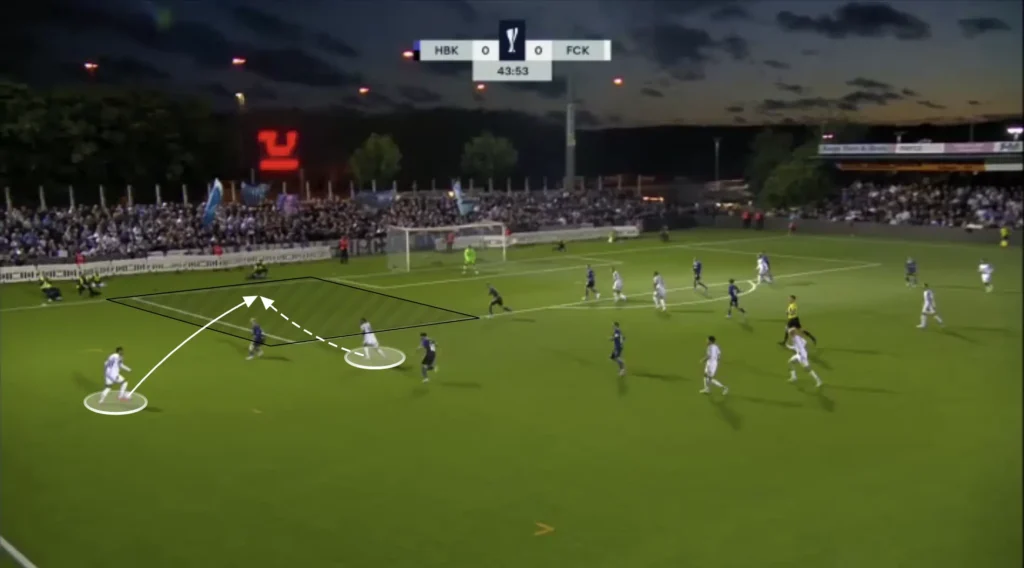
The winger does not have to play the ball to the underlapping player. The run from the attacking midfielder will often drag away an opposition defensive midfielder, which opens the space inside. The winger can take the ball inside and shoot or find a pass to a free player in front of the backline.
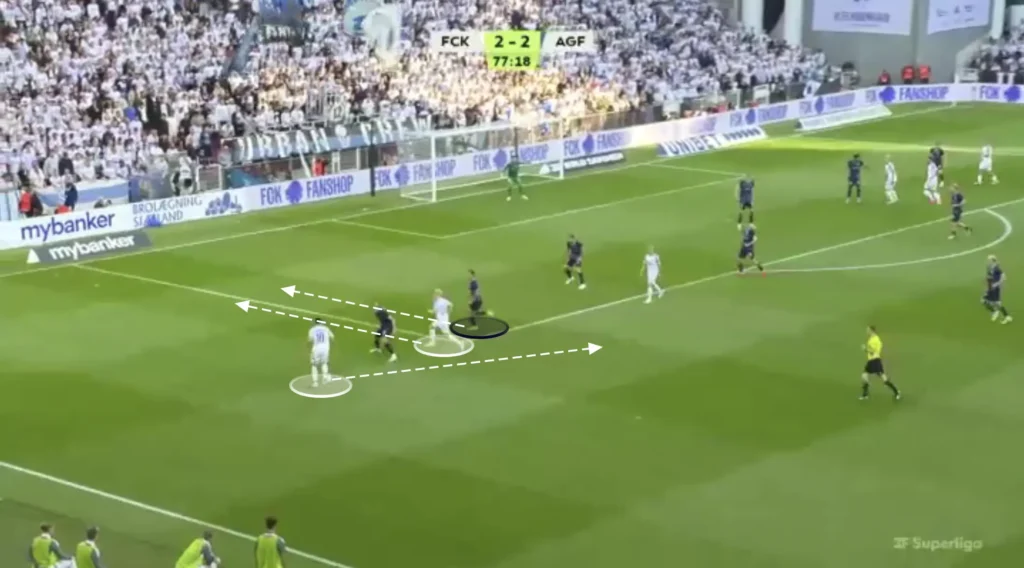
Overlaps
Copenhagen will also use overlaps to produce opportunities in the final third. When the winger gets the ball, and the fullback is nearby, the fullback can make the overlapping run, creating a 2v1 against the opposition fullback.
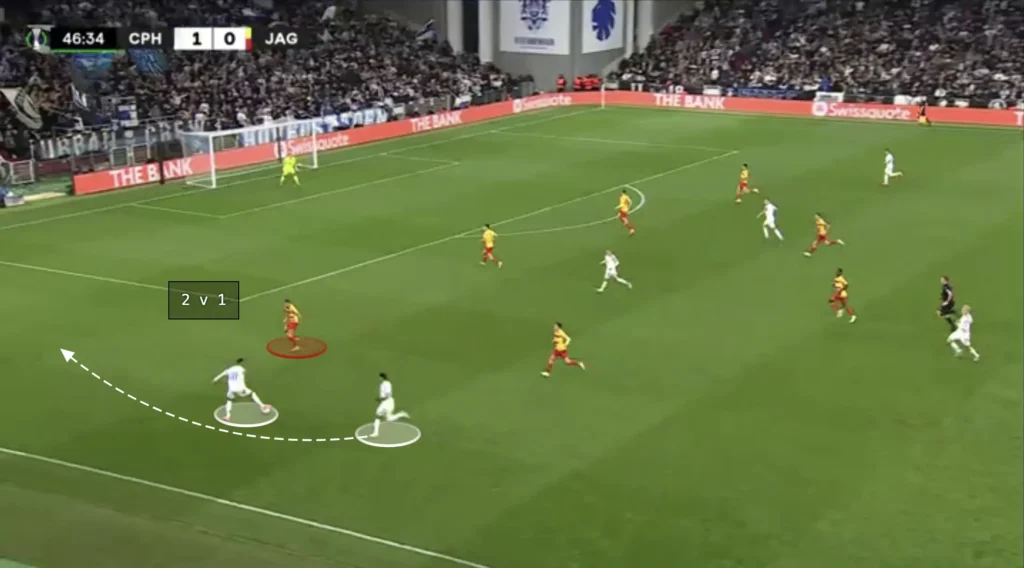
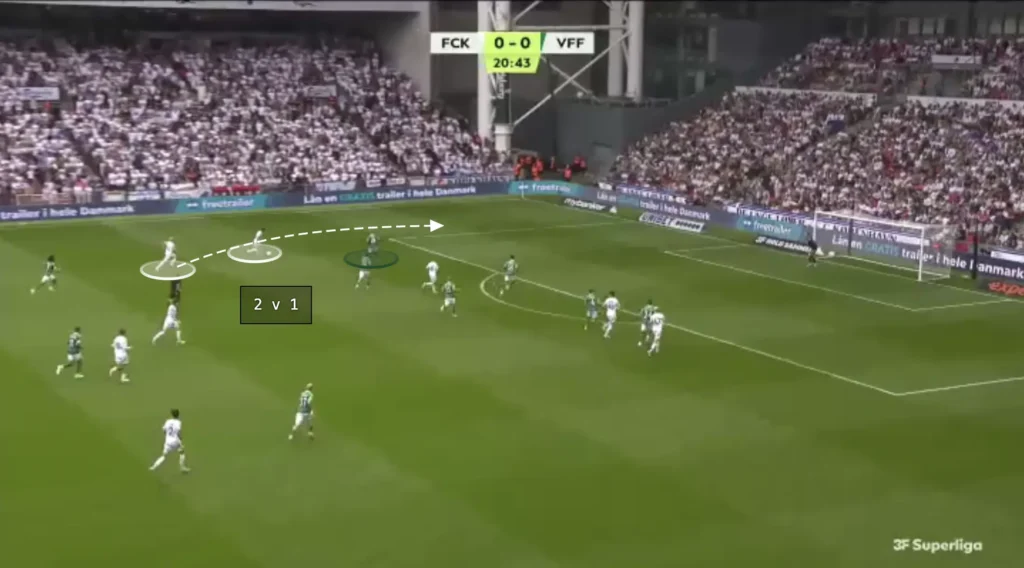
The overlap forces the defending fullback to make difficult decisions—either stick with the winger or follow the overlapping fullback. If the opposition fullback drops to cover the overlapping run, the winger could cut inside and take a shot or combine with a midfielder. If the fullback covers the center, the ball can easily be played to the overlapping player, creating a crossing opportunity.
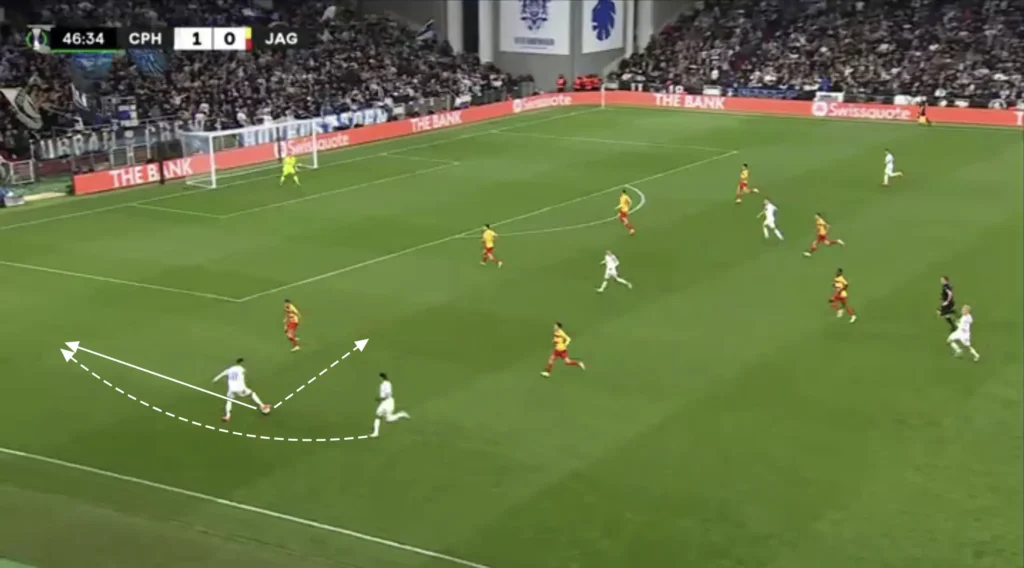
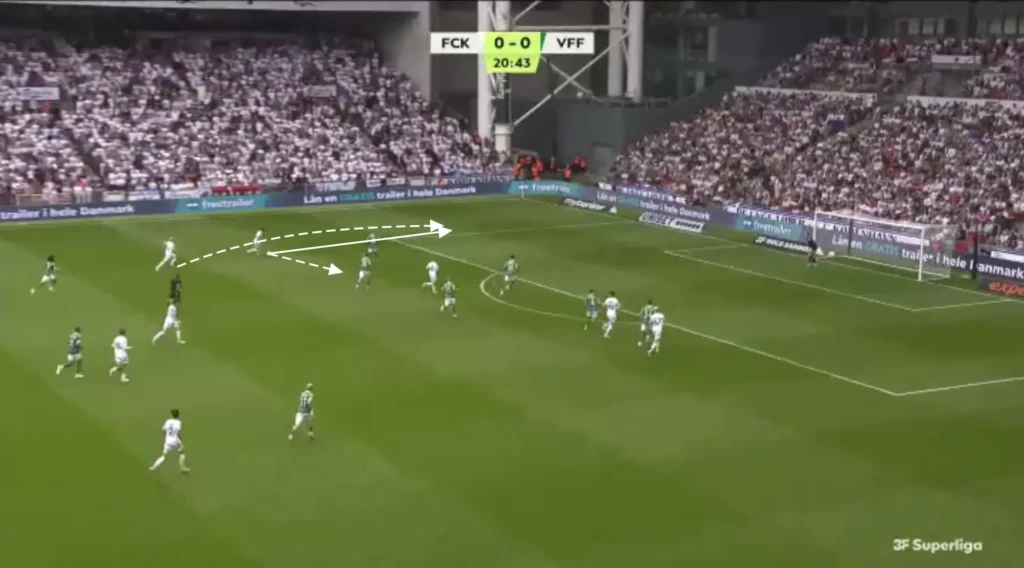
Many Players in the Box
The midfielders and wingers also look to make runs into the box when the ball is in the final third, often getting four or five players into these areas to create overloads. The numerical advantages in the box increase the chances of connecting with the cross, as more players present multiple targets for the crosser, making it harder for defenders to mark everyone effectively. Additionally, having multiple players in the box provides options for different types of finishes, whether it’s a header, volley, or a quick tap-in. It also allows for better positioning to react to second balls or rebounds, increasing the likelihood of capitalizing on any defensive errors.
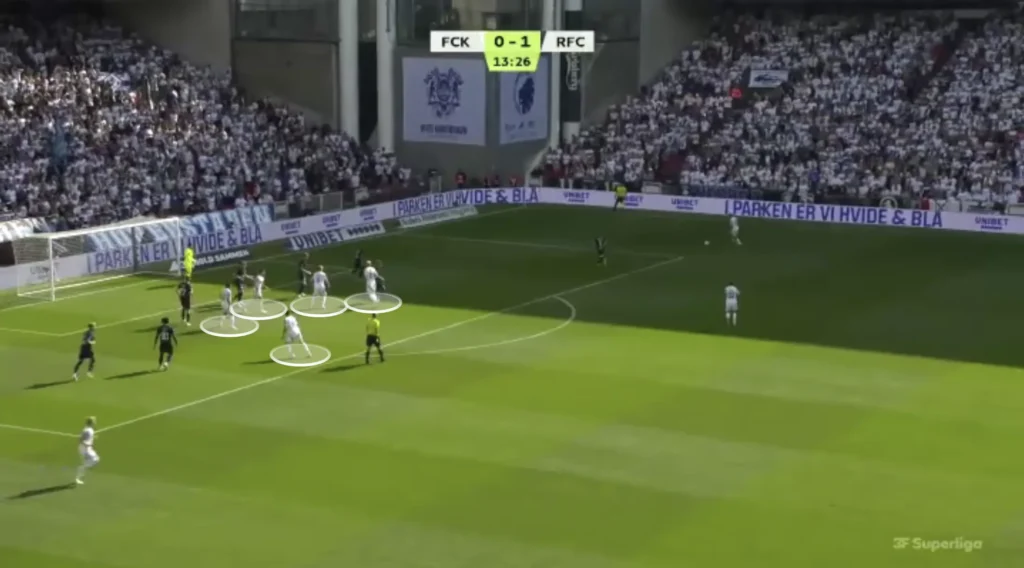
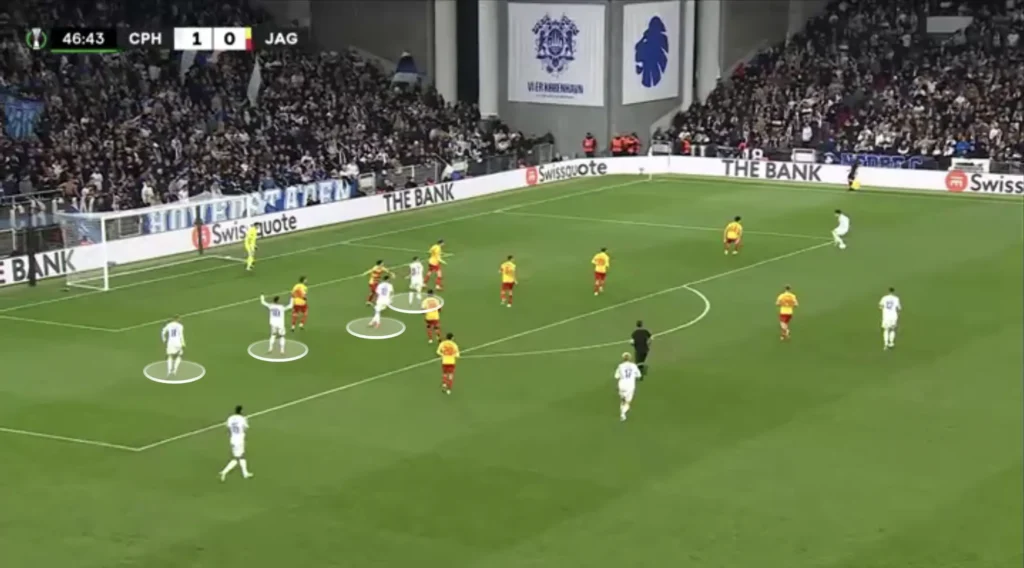
Neestrup also positions many players outside the box, ready for the second balls and cut-backs. Copenhagen will often create crossing opportunities, which pushes down the opposition’s defense and opens the space in front of the opposition’s backline. The holding midfielders can collect any loose balls or be found directly in these spaces with cut-backs, and from there, they can shoot or combine with an attacker to create goalscoring opportunities.
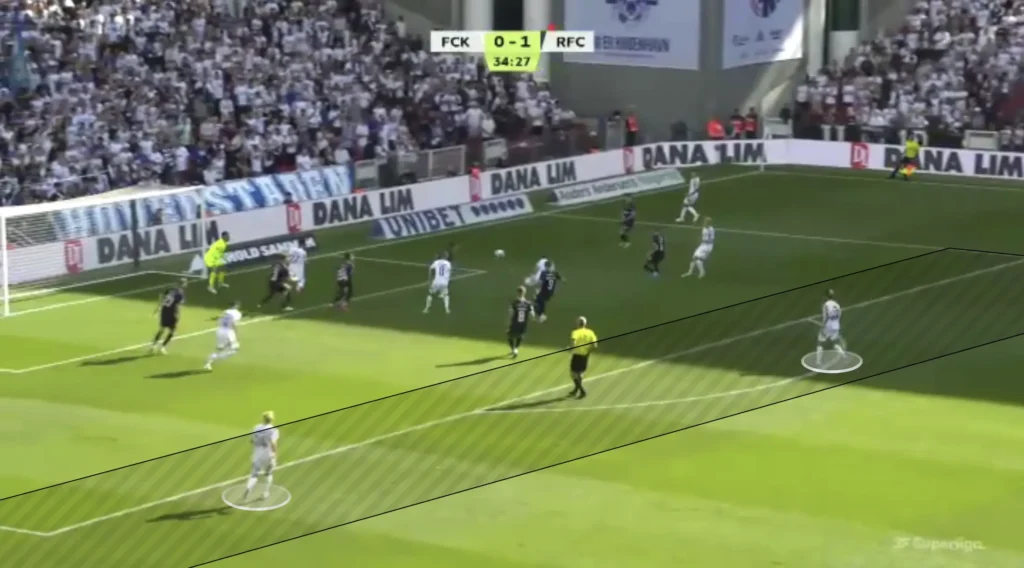
Defending
Jacob Neestrup’s FC Copenhagen are known for their tactical flexibility, particularly when it comes to their defensive formations. In most games, they start with a 1-4-2-4/1-4-4-2 shape when defending, which provides a solid and compact structure. However, they often switch to a 1-4-3-3/1-4-5-1 formation, with one more central midfielder to shield the backline and pick up any loose balls in front of the defense. Copenhagen have also used five at-the-back formations during Neestrup’s time with the club. This versatility in their defensive approach allows FC Copenhagen to adapt to various opponents, giving them an edge in different match scenarios.
1-4-2-4/1-4-4-2
In most games, FC Copenhagen defend in a 1-4-2-4 formation, looking to set up in a mid-block, always closing the center and forcing the opposition out wide.

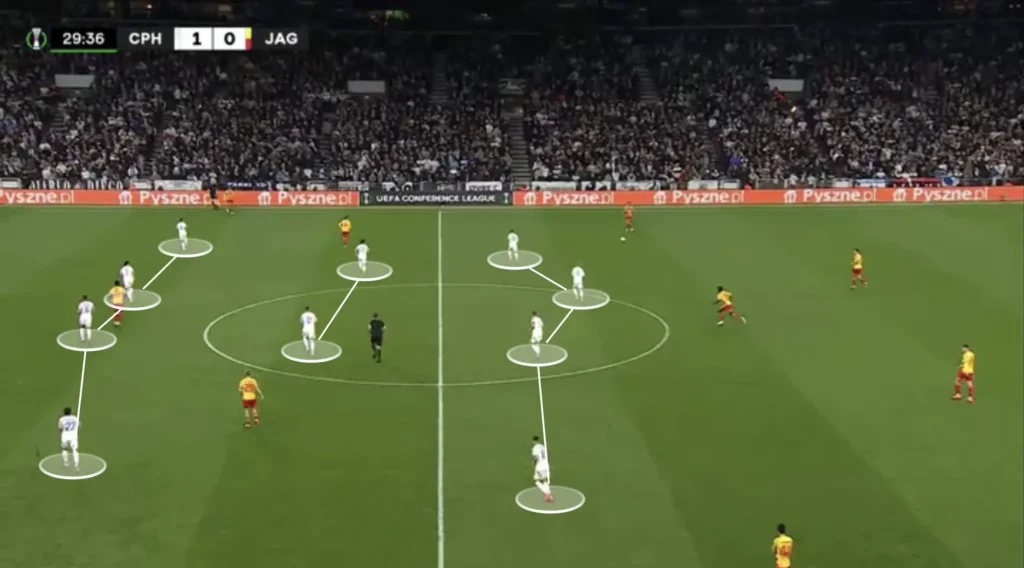
Defending in a 1-4-2-4 formation requires a careful balance between pressing high and maintaining defensive solidity. The two central midfielders play a crucial role, acting as the primary shield in front of the back four, while also supporting the press when the team looks to regain possession. The front four must press aggressively, cutting off passing lanes and forcing the opposition into mistakes. The back four stays compact, with fullbacks responsible for covering wide areas while center-backs maintain a solid shape. Overall, the success of defending in this formation hinges on coordinated pressing, quick transitions, and disciplined positioning to avoid being exposed in central areas.
In Copenhagen’s 1-4-2-4 formation, the wingers will usually press the opposition center-backs while the two strikers cover the opposition’s holding midfielders.
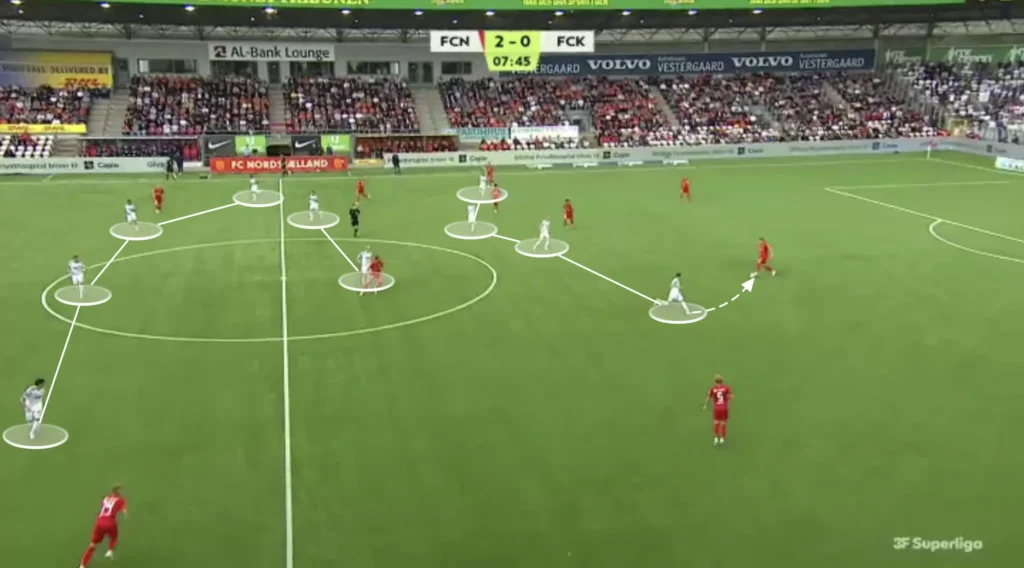
When the wingers press the center-backs, they close the passing lanes to the opposition fullbacks/wingbacks. This forces the opposition center-backs into the middle, where Neestrup wants to win the ball with the strikers, who block off all passes to the opposition midfielders.
When Copenhagen get pushed down deep into their own half, they will be less aggressive and the wingers will drop back to create a 1-4-4-2 formation, looking to provide more cover for the central midfielders.
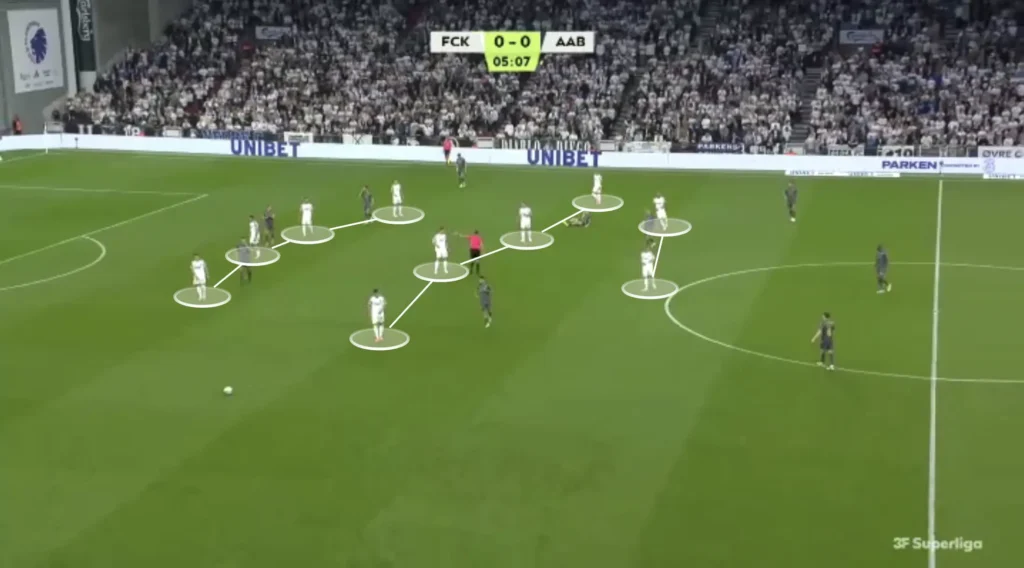
1-4-3-3/1-4-5-1
In some games, Copenhagen have used a 1-4-3-3 formation. In the 1-4-3-3 formation, they still look to set up in a compact mid-block, closing the center and stopping the opposition from penetrating through the midfield.
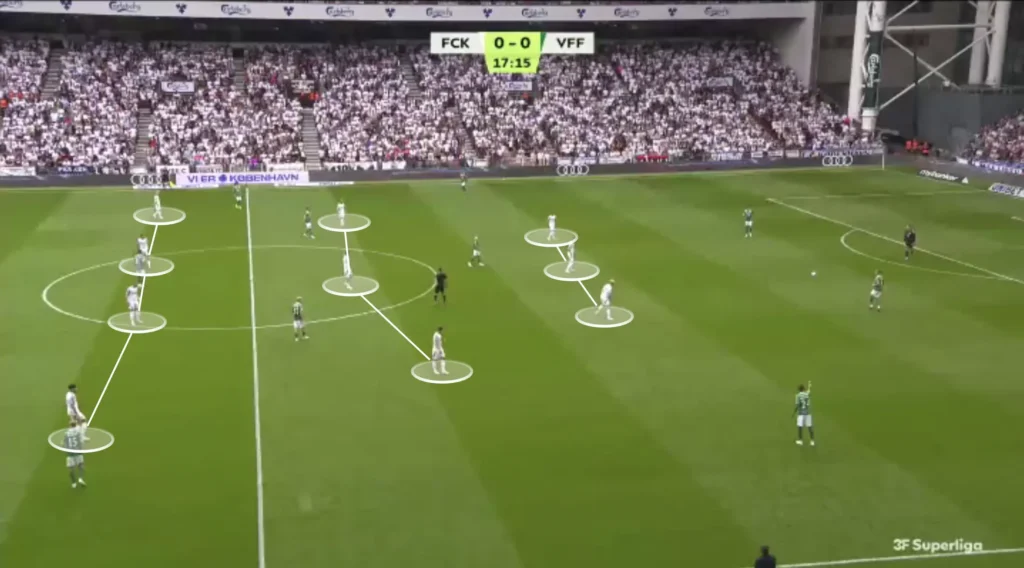
Defending in a 1-4-3-3 formation, with the wingers high up, is centered around maintaining a compact forward line that forces the opposition to progress the ball on the flanks. The team should be a cohesive unit where the three midfielders play a crucial role in shielding the back four while also supporting the high press. The 1-4-3-3 is effective in closing down the center of the field, making it difficult for opponents to penetrate through the middle, and pushing them into less dangerous wide areas. The key to successful defending in this formation is the coordination between the midfield and defense, ensuring that gaps are minimized without dropping too deep.
In Copenhagen’s 1-4-3-3 formation, the wingers will push up and press the opposition center-backs. With the winger pressing the center-back, it will be easy for the opposition to find passes straight from the center-back to the fullback, beating the forward line. When this happens, a midfielder has to break out to stop the fullback from advancing. If a central midfielder breaks out, the two remaining midfielders must shift across to close the space in the midfield.
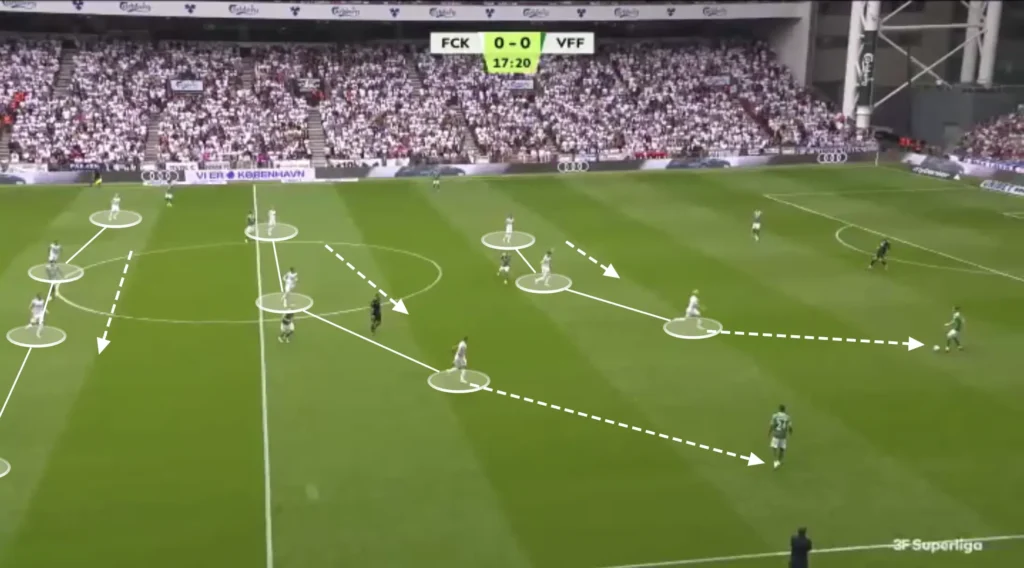
Additionally, the striker must drop back when the opposition fullback gets the ball to close off the pass inside to the holding midfielder.
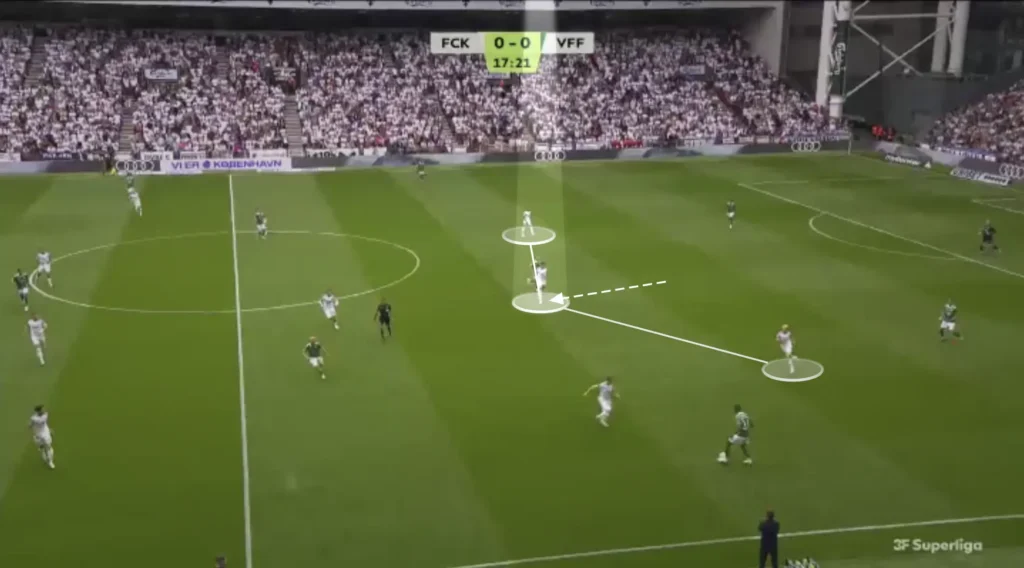
When Copenhagen play in the 1-4-3-3 system and get pushed down, the wingers will again drop back to create a 1-4-5-1 formation. This makes it more difficult to put pressure on the opposition but provides more cover in the critical areas.

Squeezing the Pitch
Jacob Neestrup always wants his team to squeeze the pitch when defending, regardless of the formation. This means constantly pushing the team up as much as possible. Every time the opponent plays a slow, sideways pass or a back pass, Copenhagen’s first line of pressure pushes up, with the rest of the team following to stay compact. When the next pass comes, they push up even more, forcing the opponent back even more. They do this because it pushes the opponent further away from Copenhagen’s goal, making it harder to create chances.
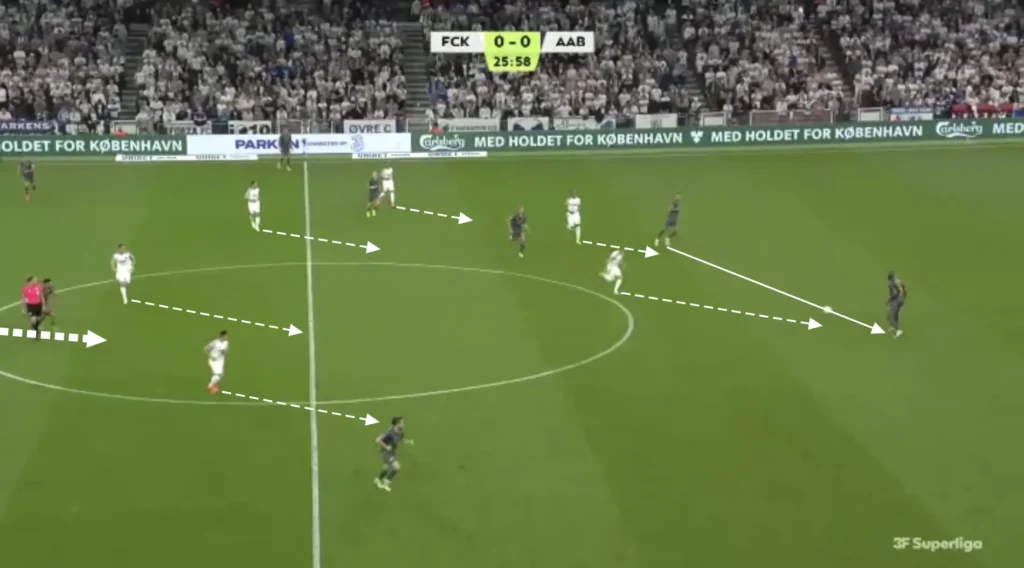
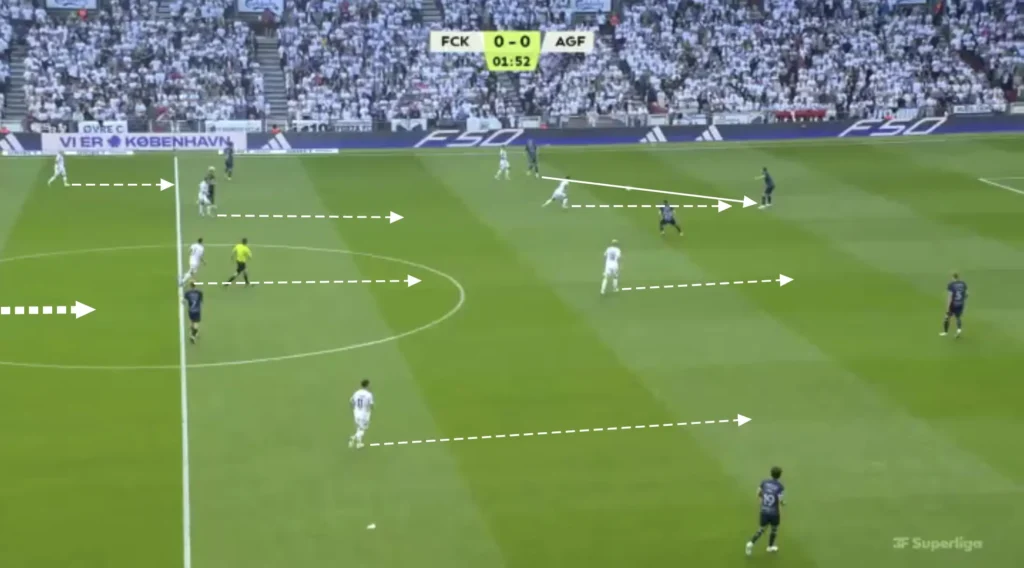
High Press
FC Copenhagen usually look to press the opposition high up the pitch. Their pressing structure will depend on the opposition, but they primarily press in a 1-4-1-3-2 formation.
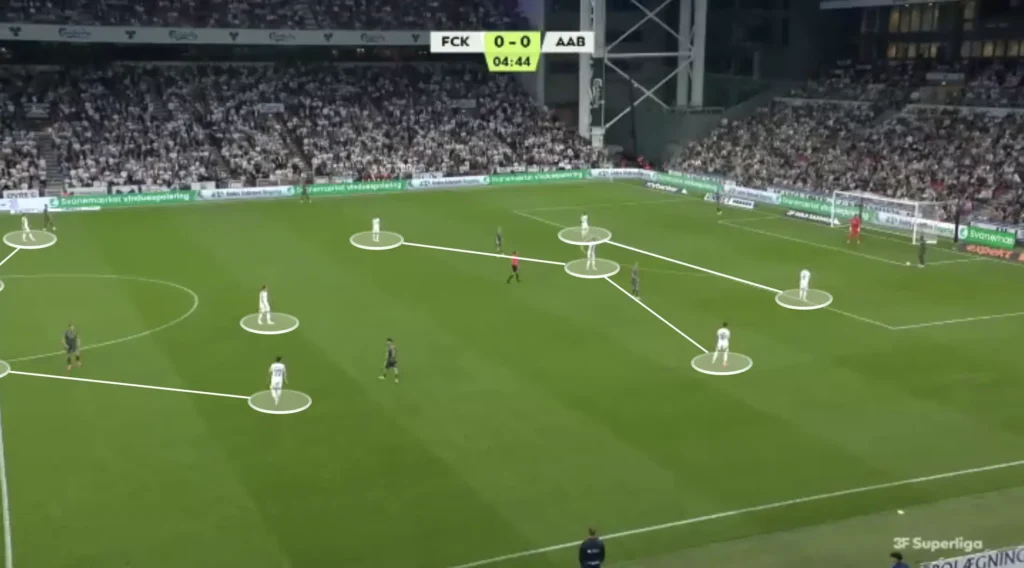
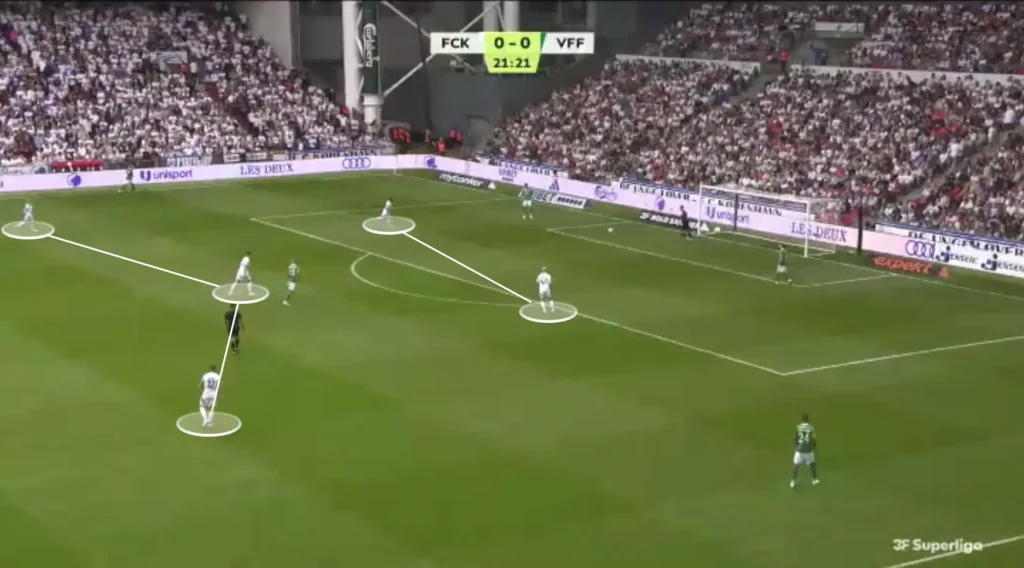
When the play starts, the strikers will try to close off one opposition center-back by making angled pressing runs, forcing the opposition to one side. The ball-side wide midfielder pushes up on the ball-side opposition fullback, with the rest of the midfield shifting across to close down any passing options.
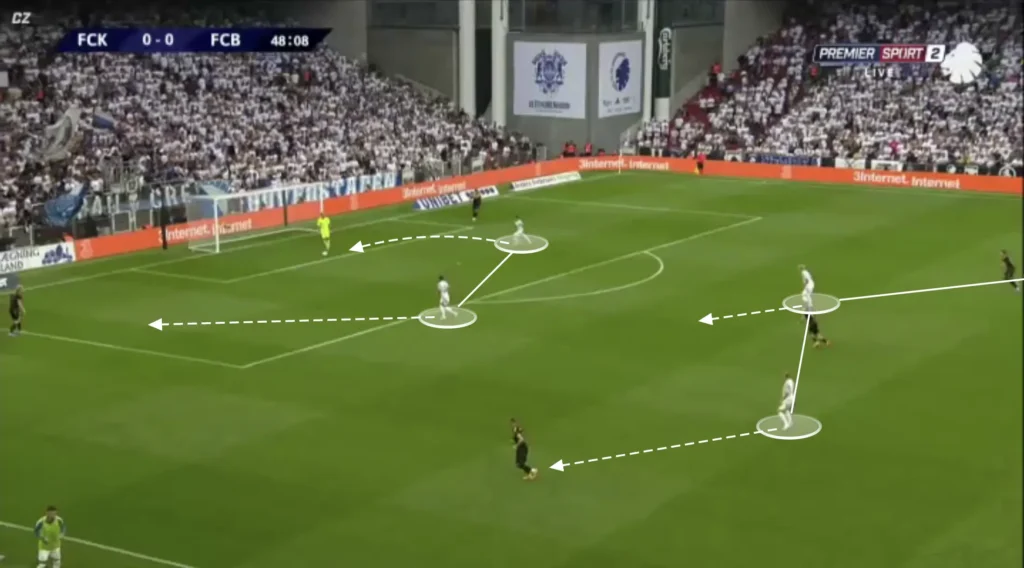
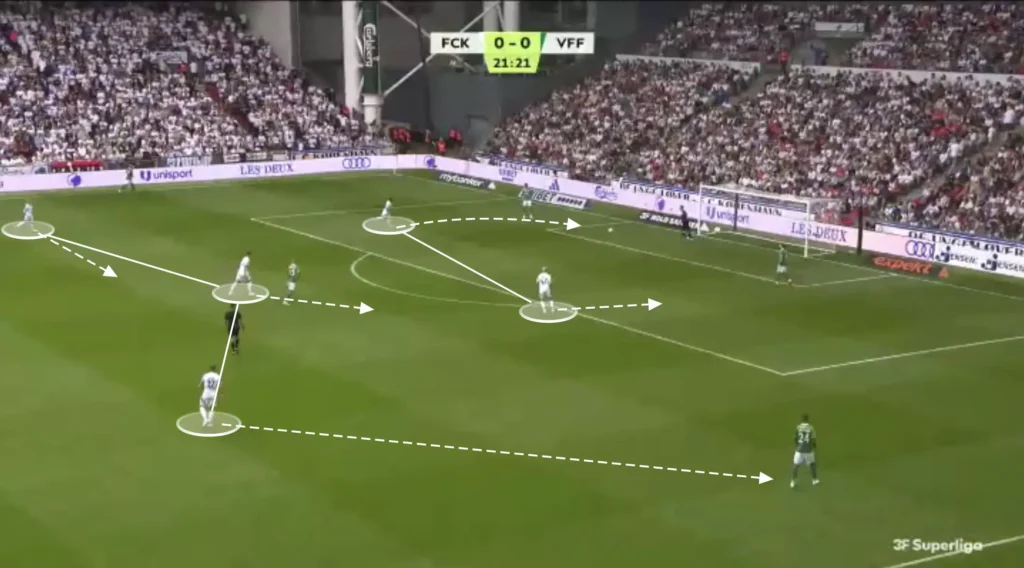
Copenhagen will be extremely aggressive and intensely press to win the ball when it gets played out to one of the opposition fullbacks. The wide midfielder will press from the inside, closing any passes into the middle. The ball-side striker will try to stop the opposition from switching sides by pushing up on the ball-side center-back, while the far-side striker comes over, ready to press the goalkeeper or holding midfielder. Meanwhile, Copenhagen’s midfielders, who have shifted across, will push up on the opposition midfielders. This gives the opposition fullback very few passing options and often triggers a rushed long ball.
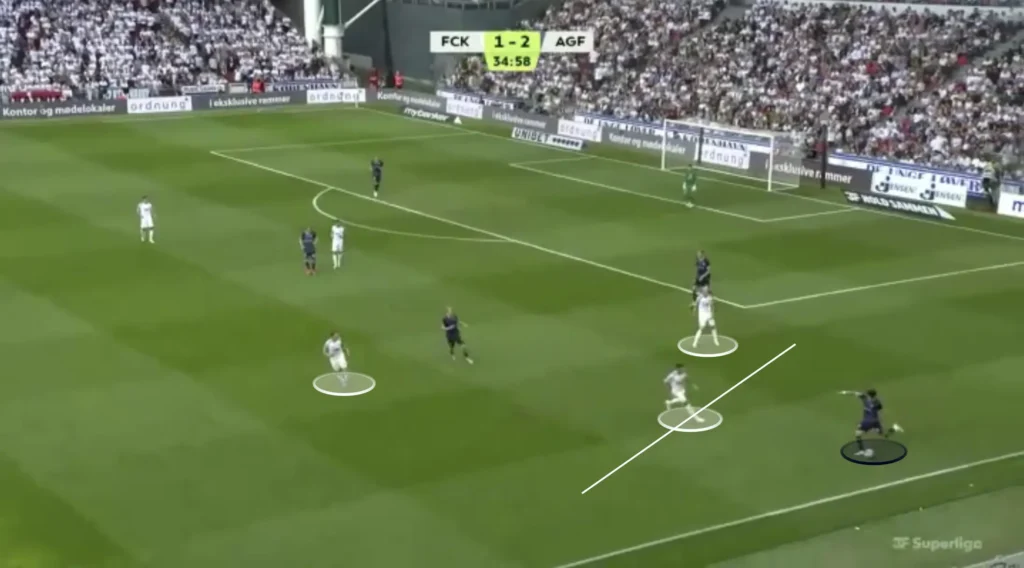
Additionally, this system gives the Copenhagen backline a numerical advantage against the opposition attackers, which means they usually win the long balls.
Transitions
Defensive Transitions
Positioning many players centrally, creating a numerical advantage in the midfield, creates good conditions in defensive transitions. Many players close to the ball after losing possession means that many players can work towards regaining possession. Neestrup’s players are also very aggressive in the first seconds after losing the ball. The four or five players closest will immediately jump on the opposition player with the ball and close the distance to cut off any passing lanes. This approach disrupts the opponent’s transition from defense to attack, forcing errors and creating opportunities to regain control in dangerous areas.
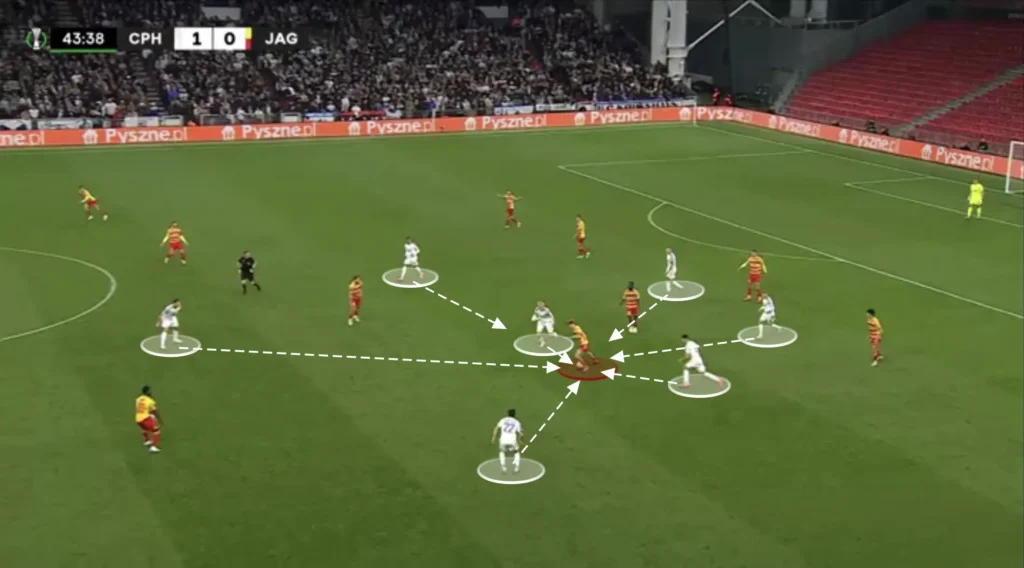
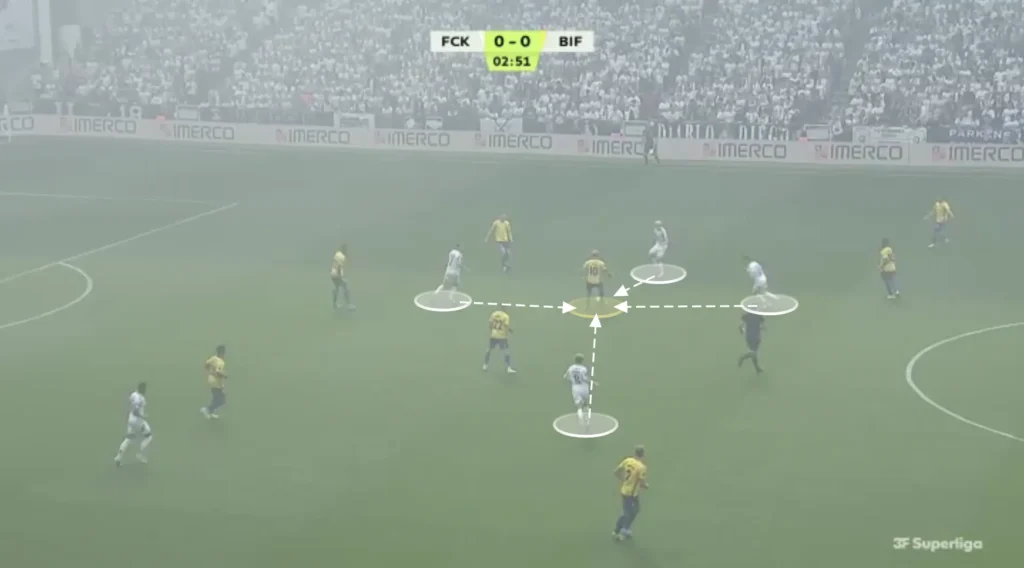
Counterpressing like this keeps Copenhagen on the front foot, allowing them to dominate possession and create more scoring opportunities. However, it requires exceptional fitness, tactical discipline, and teamwork.
Offensive Transitions
Jacob Neestrup also wants his team to counterattack in their offensive transitions. When winning the ball, the team transitions quickly from defense to attack, utilizing the speed and movement of their forward players. Neestrup emphasizes vertical passes to exploit spaces left by the opposition, often targeting wide areas or gaps between defenders. Copenhagen’s counterattacks are well-organized, with players making intelligent off-the-ball runs to create overloads and support the ball carrier. This quick, direct style catches opponents off guard, making Copenhagen a dangerous team on the break.
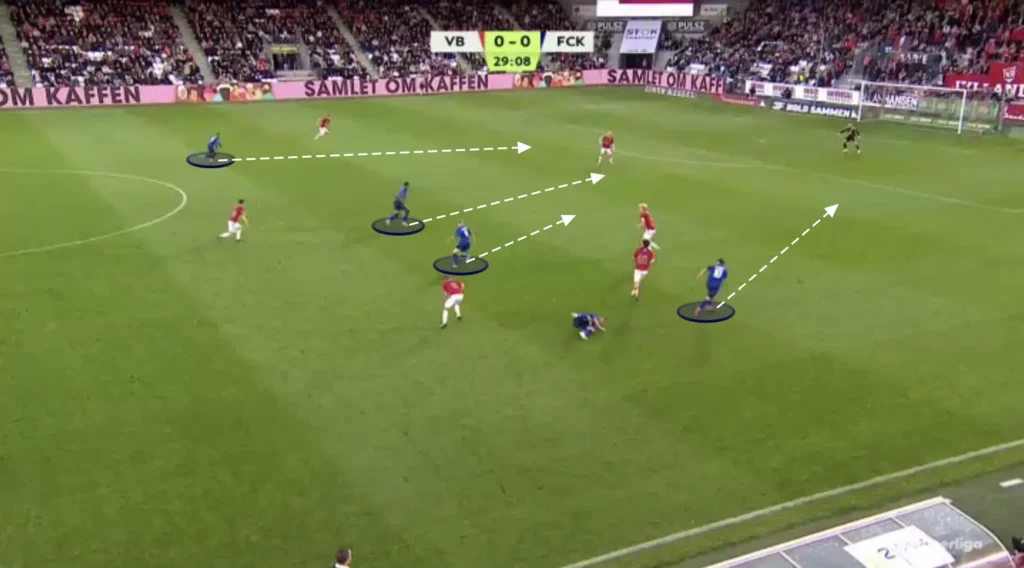
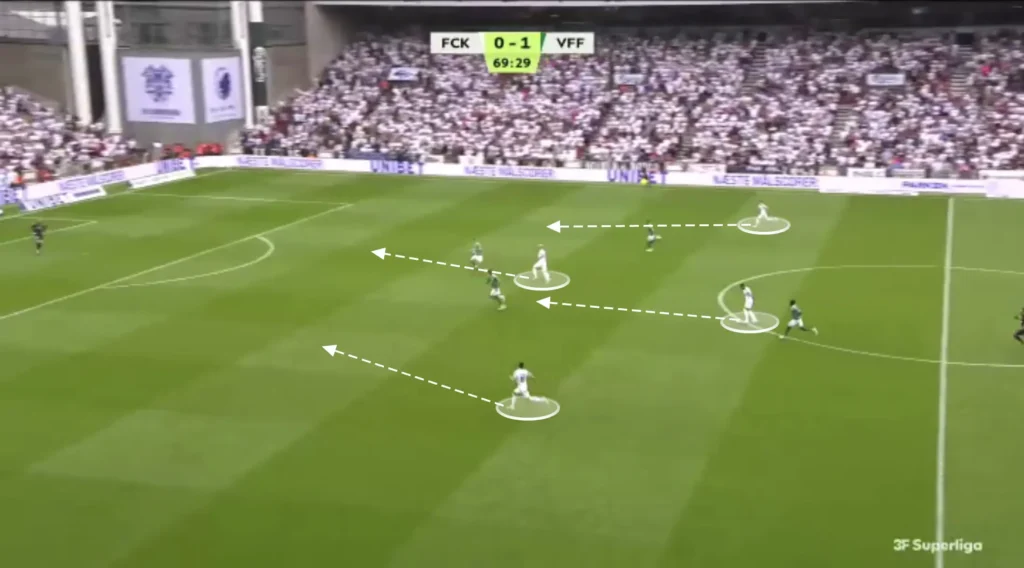
Additionally, the Copenhagen players are great at finding open spaces in the counterattacks. Instead of playing the ball straight forward where opposition defenders may still be positioned, they play a diagonal pass, allowing the team to bypass pressure and shift the play into open areas. From these areas, the Copenhagen attackers can take the ball forward and combine with each other to quickly get past the opposition and create a goalscoring opportunity.
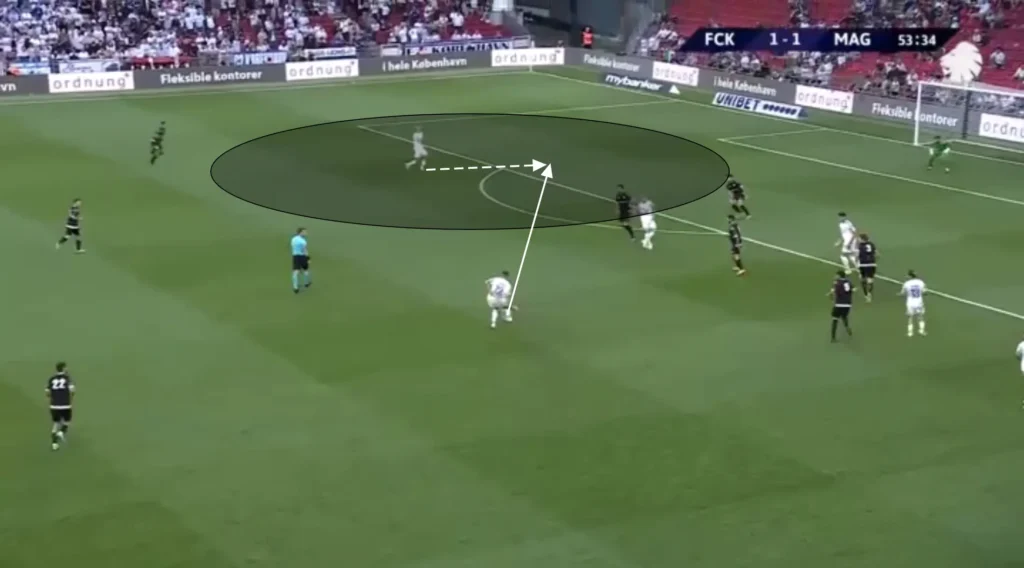
Copenhagen’s aggressiveness also means they have many players high up when defending, which enables them to incorporate more players into the counterattacks.
Final Thoughts
In conclusion, Jacob Neestrup’s tactical approach at FC Copenhagen has proven to be both innovative and effective. His strategic emphasis on disciplined defensive structures, combined with fluid and precise attacking movements, showcases his understanding of the game and his adaptability as a manager. By maintaining a balance between defensive solidity and dynamic forward play, Neestrup has transformed FC Copenhagen into a resilient and versatile team capable of competing at the highest levels.
As Neestrup continues to refine his tactics, FC Copenhagen looks set to grow even stronger, with a clear identity and a cohesive style of play. His tactical vision has not only enhanced the team’s performance but also made them a formidable force in domestic and European competitions. Fans and analysts alike will be eager to watch how Neestrup’s strategic approach further evolves, shaping the future of FC Copenhagen.
